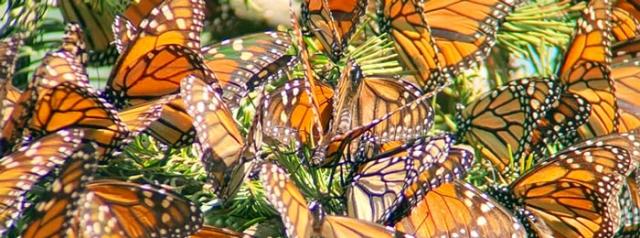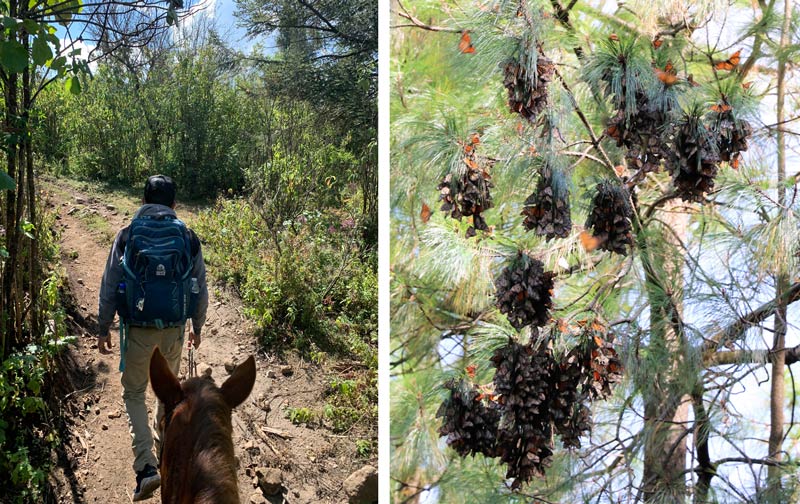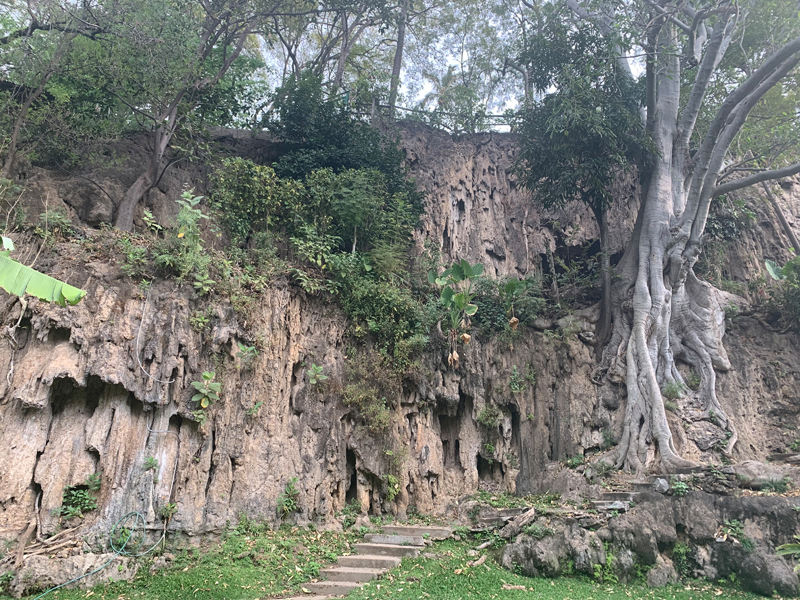The Holbrook Explorer

Behind the Scenes of the Monarch Migration Expedition with Stephanie Kowacz
Behind the Scenes of the Monarch Migration Expedition with Stephanie Kowacz
Ever wonder how a travel provider manages field operations to make trips go smoothly? Or handles a challenge in the field? Holbrook’s COO, Stephanie Kowacz, has experienced it all in her 30-year Holbrook career. Back from a week in Mexico, she shared how she prepares local partners for groups heading to view the Monarch Migration.
 Monarch butterfly cluster by Stephanie Kowacz
Monarch butterfly cluster by Stephanie Kowacz
 Stephanie in the field (L); Rodrigo, one of Holbrook's local partners, at Agua Blanca Waterfall (R)
Stephanie in the field (L); Rodrigo, one of Holbrook's local partners, at Agua Blanca Waterfall (R)
Q: What kinds of behind-the-scenes preparations do you do with Holbrook field partners?
Stephanie: I do everything from visiting the various sites that our participants will be enjoying on their program to meeting with in-country guides, checking out transportation, visiting the hotels, and meeting the hotel staff. For the monarch program, it's also a matter of learning about where the butterfly colonies are in the sanctuaries and facilitating the safest experience for our passengers. So this trip was good to touch base with everyone again and just be prepared for the season.
 Hotel Don Bruno in Angangueo by Stephanie Kowacz
Hotel Don Bruno in Angangueo by Stephanie Kowacz
 Meeting hotel staff at Don Bruno; photo by Stephanie Kowacz
Meeting hotel staff at Don Bruno; photo by Stephanie Kowacz
Q: What makes the Monarch Migration trip unique operationally?
Stephanie: From an operational standpoint these trips are unique in that you don't know from year to year, even from trip to trip, where the colonies are going to be. As the weather changes, they move up and down the mountains, so it's important to have a good, tight relationship with the local rangers in each reserve. And each reserve is run by the local community, so you're making sure that you understand where you can see the colonies and understanding the challenges of terrain, at what elevation you're at so that we can prepare our travelers for cooler weather and everything like that.
 Mountain scenery by Stephanie Kowacz
Mountain scenery by Stephanie Kowacz
 Riding horseback up the mountain (L); monarch clusters in the trees (R); photos by Stephanie Kowacz
Riding horseback up the mountain (L); monarch clusters in the trees (R); photos by Stephanie Kowacz
Q: How many years has Holbrook been operating trips to this region in Mexico?
Stephanie: We've been running these trips on a consistent, annual basis since 2015; however, we have hosted programs in this region as long ago as 20 years ago. The program developed from the amazing work of the late Dr. Thomas Emmel, who was the head of the McGuire Center for Lepidoptera at the Florida Museum of Natural History. He was a professor at the University of Florida as well, and a friend to the monarchs. I had the great pleasure of traveling with him a few years ago, which was such an amazing experience. We are proud to be continuing his good work.
 Looking skyward; photo by Ian Segebarth
Looking skyward; photo by Ian Segebarth
Q: Can you outline the current itinerary?
Stephanie:We typically run a six-night program with visits to three monarch sanctuaries. The first night is in Mexico City, right in the historic center. The next morning, we have a walking exploration of the National Palace and the Metropolitan Cathedral, then we're off to Angangueo for two nights. We visit El Rosario sanctuary and Sierra Chincua, then go to Agua Blanca, which is at a lower elevation so it's a warmer, subtropical environment. The hotel is in an amazing spot with an elevated position over a beautiful river with nice trails and mineral hot springs. It has access to the third reserve, which is Cerro Pelón, which is the most difficult. Typically you can only go via horseback, so some people tend to opt out of this third visit and enjoy the birds, nature, waterfall, and hot springs at the hotel. The next day we go back to Mexico City and visit the amazing ruins at Teotihuacán before a farewell dinner, where we learn a little bit about Mexican cuisine with a special talk by a local food expert. The next morning we head home.
 Hotel Agua Blanca pool and scenery by Stephanie Kowacz
Hotel Agua Blanca pool and scenery by Stephanie Kowacz
 Street food vendor (L) and Agua Blanca Waterfall (R); photos by Stephanie Kowacz
Street food vendor (L) and Agua Blanca Waterfall (R); photos by Stephanie Kowacz
Q: Would you say viewing the Monarch Migration is a bucket-list trip? If so, for what type of interests does it most appeal?
Stephanie: I think that anyone who's interested in nature is going to love this trip. Sometimes when you hear the words "bucket list," you also think of a longer, iconic and expensive trip. This one's short and definitely affordable. It's accessible to people of all different ages and working people. If you like nature, butterflies and a little mix of culture, this is ideal. This trip gives you a little bit of everything: an amazing nature phenomenon, beautiful forests, waterfalls, mountains, amazing ruins, and then the vibrant, colonial Mexico City.
 Monarchs in flight by Ian Segebarth
Monarchs in flight by Ian Segebarth
 View of Mexico City's historical city center by Stefanie Plein
View of Mexico City's historical city center by Stefanie Plein
Q: Holbrook is known for its in-depth educational experiences. How does this trip follow that model?
Stephanie: We have pre-talks preparing you for the visits to the sanctuaries. But it’s a little different in the sense that when you're in the sanctuary, as you get to the colonies, you're encouraged to stay quiet and to really absorb the experience. It can be very spiritual for some people, and so a lot of the educational experience is one of self-reflection and natural discovery. The educational interpretation that we’re so well-known for is held in the evenings, on visits to towns, and in Mexico City.
 Monarchs in El Rosario Sanctuary by Pelin Karaca
Monarchs in El Rosario Sanctuary by Pelin Karaca
Q: What are some precautions travelers need to take in the field due to the pandemic?
Stephanie: Preparation is key on any program, especially now as rules and entry requirements to each country are ever-changing due to COVID and for requirements coming back to the United States. It's very important to understand what types of entry requirements you have, in this case for Mexico. We recommend you have your vaccination records handy and also on your phone as well as a paper copy of them. With Mexico, there is a required Health Questionnaire that must be completed within 12 hours of your flight; it generates a QR code digitally; also bring a printed copy, just in case. I cannot stress enough the importance of having travel insurance to cover against quarantine expenses. Of course, you need your face masks and hand sanitizer, but that’s a way of life now.
 Agua Blanca rock formation by Stephanie Kowacz
Agua Blanca rock formation by Stephanie Kowacz
Q: Were there any memorable experiences for you on this visit? Anything that you want to share?
Stephanie: I'm always just surprised by the resilience of people; it has been a difficult two years. I've been in several countries where I’ve met with the people who have suffered due to the lack of tourism. In these small communities like Angangueo and Jungapeo, the majority of their tourism income happens during this migration and mostly in January and February. So to even miss one year is really hard. It really struck me how much our visits to these sanctuaries support these local communities, and then in turn these local communities protect the monarchs. I'm just so thankful for that.
 The Ruta Mariposa Monarca (Monarch Butterfly Route) by Stephanie Kowacz
The Ruta Mariposa Monarca (Monarch Butterfly Route) by Stephanie Kowacz
Q: So are the communities beginning to see the impact of visitors again?
Stephanie: Absolutely. We just had a group of 28 return from a trip with the Florida Museum of Natural History, where it all started with Dr. Emmel. I've heard really positive feedback from them. And then currently, we have two other small groups in the field from the US. Then we have another two coming up soon. We've had a pretty busy year considering the circumstances. That's great for the monarchs and the local communities.
 Monarchs up close by Pelin Karaca
Monarchs up close by Pelin Karaca
 Holbrook group at Teotihuacán
Holbrook group at Teotihuacán
Q: Any other advice for deciding to travel internationally again?
Stephanie: I think that whether to travel or not is a personal decision. I feel that every time I'm leaving my home and going somewhere outside my home and out in public, I’m traveling — even if it's just to the grocery store. So for me, you take the same precautions that you take when you do that. You follow the protocols. You pack your hand sanitizer, your masks, your patience, and go off and travel. I know that others share this spirit of adventure and are continuing their travels. For me, travel is a necessity!

